《药理学》课程PPT教学课件(Cardiovascular Sys)25 treatment for arrthymia2
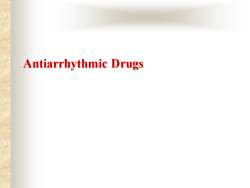
Antiarrhythmic Drugs
Antiarrhythmic Drugs
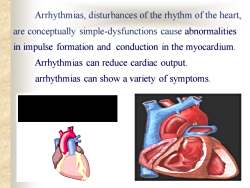
Arrhythmias,disturbancesoftherhythmoftheheart.are conceptually simple-dysfunctions cause abnormalitiesin impulse formation and conduction in the myocardiumArrhythmias can reduce cardiac outputarrhythmias can show a variety of symptoms
Arrhythmias, disturbances of the rhythm of the heart, are conceptually simple-dysfunctions cause abnormalities in impulse formation and conduction in the myocardium. Arrhythmias can reduce cardiac output. arrhythmias can show a variety of symptoms
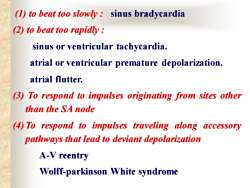
()to beattoo slowly:sinus bradycardia(2) to beat too rapidly :sinus or ventricular tachycardia.atrial or ventricular premature depolarizationatrial flutter.3) To respond to impulses originatingfrom sites otherthanthe SAnode(4) To respond to impulses traveling alongaccessorypathways that lead to deviant depolarizationA-VreentryWolff-parkinson White syndrome
(1) to beat too slowly : sinus bradycardia (2) to beat too rapidly : sinus or ventricular tachycardia. atrial or ventricular premature depolarization. atrial flutter. (3) To respond to impulses originating from sites other than the SA node (4)To respond to impulses traveling along accessory pathways that lead to deviant depolarization A-V reentry Wolff-parkinson White syndrome
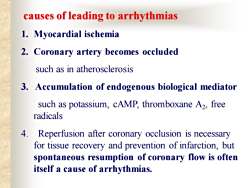
causes of leading to arrhythmias1. Myocardial ischemia2. Coronary artery becomes occludedsuch as in atherosclerosis3. Accumulation of endogenous biological mediatorsuch as potassium, cAMP, thromboxane A2, freeradicals4. Reperfusion after coronary occlusion is necessaryfor tissue recovery and prevention of infarction, butspontaneous resumption of coronary flow is oftenitself a cause of arrhythmias
causes of leading to arrhythmias 1. Myocardial ischemia 2. Coronary artery becomes occluded such as in atherosclerosis 3. Accumulation of endogenous biological mediator such as potassium, cAMP, thromboxane A2 , free radicals 4. Reperfusion after coronary occlusion is necessary for tissue recovery and prevention of infarction, but spontaneous resumption of coronary flow is often itself a cause of arrhythmias
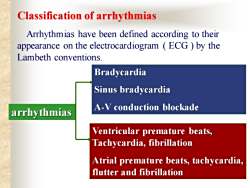
Classification ofarrhythmiasArrhythmias have been defined according to theirappearance on the electrocardiogram (ECG) by theLambeth conventionsBradycardiaSinus bradycardiaA-V conduction blockadearrhythmiasVentricular premature beats,Tachycardia,fibrillationAtrialprematurebeats,tachycardia,flutter and fibrillation
Classification of arrhythmias Arrhythmias have been defined according to their appearance on the electrocardiogram ( ECG ) by the Lambeth conventions. arrhythmias Bradycardia Sinus bradycardia A-V conduction blockade Ventricular premature beats, Tachycardia, fibrillation Atrial premature beats, tachycardia, flutter and fibrillation
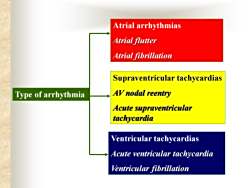
AtrialarrhythmiasAtrialflutterAtrialfibrillationSupraventricular tachycardiasAV nodal reentryType of arrhythmiaAcute supraventriculartachycardiaVentricular tachycardiasAcute ventricular tachycardiaVentricular fibrillation
Type of arrhythmia Atrial arrhythmias Atrial flutter Atrial fibrillation Supraventricular tachycardias AV nodal reentry Acute supraventricular tachycardia Ventricular tachycardias Acute ventricular tachycardia Ventricular fibrillation
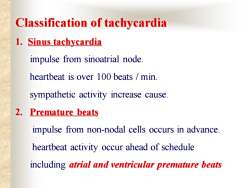
Classification of tachycardia1. Sinus tachycardiaimpulse from sinoatrial nodeheartbeat is over 100 beats / minsympathetic activity increase cause.2.Premature beatsimpulse from non-nodal cells occurs in advanceheartbeat activity occur ahead of scheduleincluding atrial and ventricular premature beats
Classification of tachycardia 1. Sinus tachycardia impulse from sinoatrial node. heartbeat is over 100 beats / min. sympathetic activity increase cause. 2. Premature beats impulse from non-nodal cells occurs in advance. heartbeat activity occur ahead of schedule including atrial and ventricular premature beats
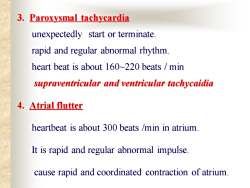
3.Paroxysmaltachycardiaunexpectedly start or terminaterapid and regular abnormal rhythmheart beat is about 160~220 beats / minsupraventricular andventricular tachycaidia4.Atrial flutterheartbeat is about 300 beats /min in atriumIt is rapid and regular abnormal impulsecause rapid and coordinated contraction of atrium
3. Paroxysmal tachycardia unexpectedly start or terminate. rapid and regular abnormal rhythm. heart beat is about 160~220 beats / min supraventricular and ventricular tachycaidia 4. Atrial flutter heartbeat is about 300 beats /min in atrium. It is rapid and regular abnormal impulse. cause rapid and coordinated contraction of atrium
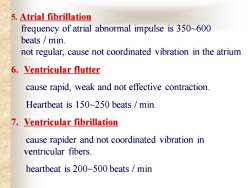
5.Atrial fibrillationfrequency of atrial abnormal impulse is 350~600beats / min.not regular, cause not coordinated vibration in the atrium6.Ventricularfluttercause rapid, weak and not effective contraction.Heartbeat is 150~250 beats / min7.Ventricularfibrillationcause rapider and not coordinated vibration inventricular fibersheartbeat is 200~500beats / min
5. Atrial fibrillation frequency of atrial abnormal impulse is 350~600 beats / min. not regular, cause not coordinated vibration in the atrium 6. Ventricular flutter cause rapid, weak and not effective contraction. Heartbeat is 150~250 beats / min. 7. Ventricular fibrillation cause rapider and not coordinated vibration in ventricular fibers. heartbeat is 200~500 beats / min
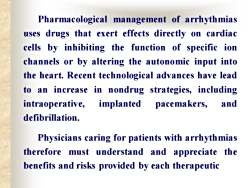
Pharmacological management of arrhythmiasuses drugs that exert effects directly on cardiaccells by inhibiting the function of specific ionchannels or by altering the autonomic input intothe heart. Recent technological advances have leadto an increase in nondrug strategies, includingandintraoperative,implantedpacemakers,defibrillation.Physicians caring for patients with arrhythmiasthetherefore must understand and appreciatebenefits and risks provided by each therapeutic
Pharmacological management of arrhythmias uses drugs that exert effects directly on cardiac cells by inhibiting the function of specific ion channels or by altering the autonomic input into the heart. Recent technological advances have lead to an increase in nondrug strategies, including intraoperative, implanted pacemakers, and defibrillation. Physicians caring for patients with arrhythmias therefore must understand and appreciate the benefits and risks provided by each therapeutic
按次数下载不扣除下载券;
注册用户24小时内重复下载只扣除一次;
顺序:VIP每日次数-->可用次数-->下载券;
- 《药理学》课程PPT教学课件(Cardiovascular Sys)23 diuretic.ppt
- 《药理学》课程PPT教学课件(Cardiovascular Sys)20 anti-inflammation drugs.ppt
- 《药理学》课程PPT教学课件(Cardiovascular Sys)29 treatment for angina pectoris.ppt
- 《药理学》课程PPT教学课件(Cardiovascular Sys)27 treatment for CHF2.ppt
- 《药理学》课程PPT教学课件(Cardiovascular Sys)28 Agents Used in Hyperlipidemia.ppt
- 《药理学》课程PPT教学课件(Central Nervous Sys)12 central nervous system stimulants.ppt
- 《药理学》课程PPT教学课件(Central Nervous Sys)17 Antiparkin.ppt
- 《药理学》课程PPT教学课件(Central Nervous Sys)13 anesthesia.ppt
- 《药理学》课程PPT教学课件(Central Nervous Sys)18 neuroleptic drugs.ppt
- 《药理学》课程PPT教学课件(Central Nervous Sys)19 opioid analgesics and antagonists.ppt
- 《药理学》课程PPT教学课件(Efferent Sys)05 the autonomic nervous system.ppt
- 《药理学》课程PPT教学课件(Efferent Sys)10 adrenergic agonists.ppt
- 《药理学》课程PPT教学课件(Efferent Sys)06 cholinergic agonists.ppt
- 《药理学》课程PPT教学课件(Efferent Sys)07 adrenergic antagonists.ppt
- 《药理学》课程PPT教学课件(Efferent Sys)12 antidepression.ppt
- 《药理学》课程PPT教学课件(抗菌药物)第三十八章 抗菌药物概论.ppt
- 《药理学》课程PPT教学课件(抗菌药物)第三十九章 β-内酰胺类抗生素.ppt
- 《药理学》课程PPT教学课件(抗菌药物)第四十一章 氨基苷类抗生素.ppt
- 《药理学》课程PPT教学课件(抗菌药物)第四十章 大环内酯类.ppt
- 《药理学》课程PPT教学课件(抗菌药物)第四十三章 人工合成类.ppt
- 《药理学》课程PPT教学课件(Endocrine Sys)35 insullin.ppt
- 《药理学》课程PPT教学课件(Endocrine Sys)34 adrenocortical hormones.ppt
- 《药理学》课程PPT教学课件(Endocrine Sys)36 thyroid drugs.ppt
- 《药理学》课程PPT教学课件(Antimicrobial Drugs)43b Sulfonamides and other Synthetic Antimicrobial Drugs.ppt
- 《药理学》课程PPT教学课件(Antimicrobial Drugs)43a Quinolones and Urinary Tract Antiseptics.ppt
- 《药理学》课程PPT教学课件(Antimicrobial Drugs)41 Aminoglycosides.ppt
- 《药理学》课程PPT教学课件(Antimicrobial Drugs)42 Tetracyclines, Chloramphenicol.ppt
- 《药理学》课程PPT教学课件(Antimicrobial Drugs)38 Principles of Antimicrobial Therapy.ppt
- 《药理学》课程PPT教学课件(Antimicrobial Drugs)40 Macrolides, Lincomycin, Clindamycin.ppt
- 《药理学》课程PPT教学课件(Antimicrobial Drugs)39 Inhibitors of Cell Wall Synthesis.ppt
- 《生物药剂学与药物动力学》课程教学大纲 Biopharmaceutics and Pharmacokinetics.doc
- 《生物药剂学与药物动力学》课程教学资源(教案,2012版).doc
- 《生物药剂学与药物动力学》课程教学资源(讲稿,2014版).doc
- 《生物药剂学与药物动力学》课程教学资源(试卷习题)试卷6(答案).doc
- 《生物药剂学与药物动力学》课程教学资源(试卷习题)试卷5(答案).doc
- 《生物药剂学与药物动力学》课程教学资源(试卷习题)试卷6(试题).doc
- 《生物药剂学与药物动力学》课程教学资源(试卷习题)试卷5(试题).doc
- 《生物药剂学与药物动力学》课程教学资源(试卷习题)试卷3(答案).doc
- 《生物药剂学与药物动力学》课程教学资源(试卷习题)试卷4(答案).doc
- 《生物药剂学与药物动力学》课程教学资源(试卷习题)试卷4(试题).doc
